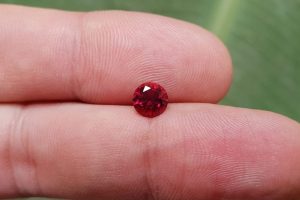Red Emerald
Emerald ID: E1499
Weight: 0.23 Carats
Origin: Colombia
There is no such thing as a red emerald. The color emerald is by definition a slightly yellowish green to bluish green. Tone and saturation also play a role in qualifying an emerald color, but the main color of the beryl must be primarily green
However, there are colors of beryl other than green. Beryl can be colorless, greenish blue, dark blue, pink, yellow, and red. The red variety of beryl is known as Bixbite, not to be confused with Bixbyte which is a separate mineral. The reason for such similar names is that both were named after the same mineralogist, Maynard Bixby. Officially, most mineralogists refer to it as red beryl to prevent confusion.
Red Beryl

While red emerald is a completely incorrect term, there is merit to the description.
Red beryl and emeralds are the same mineral species, meaning they share most of their chemical composition and crystal structure. They have the same hardness and toughness since they are the same crystal species. The toughness is notable since it is significantly impacted by inclusions, which both frequently have as gems with Type III clarity.
Clarity Types
Type I – Aquamarine

Type II – Ruby

Type III – Red Beryl

Different types of colored gems have their clarity grouped into three types. Note use the of the term colored since diamonds are not included, and thus do not have a type. As for colored gems, the types are grouped into Type I, Type II, and Type III. Type I gems are very frequently clear. Type II gems usually have some visible inclusions, with most gems falling into this type. Type III gems are so visibly included that ones that are eye-clean sell for a premium.
Sources
Emeralds form in a number of locations, primarily Colombia, though Brazil, Zambia, and Ethiopia produce gem quality material too. North Carolina, Australia, and Russia produce emeralds too, though these are rarely of gem quality or in a large enough quantities to be major emerald suppliers.
Red beryl, on the other hand, only forms in one area: Utah, USA. Primarily around the Wah Wah Mountains. Occasionally they have been found in New Mexico, but usually not in as high quality. This gemstone can be found nowhere else.


Jewelry & Trade

Much like emeralds, red beryl is an excellent gemstone to use in jewelry. It’s scratch resistant, and can be worn daily without any problems. The only issue is just how rare it is. Red beryl forms in such small amounts and is so frequently included that faceting sizes above 0.20 carats is rare. It is almost exclusively used in unique one-of-a kind jewelry, and will never be mass marketed by any jewelry company.
Despite the vivid red color, the extreme rarity and limited size cannot consistently compete with rubies on the jewelry market. There is demand for them as mineral specimens, even if the crystals are not gem quality due to sheer rarity and appeal of the color.
